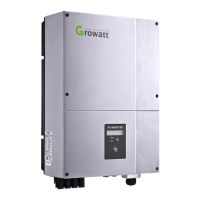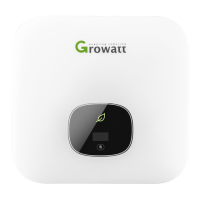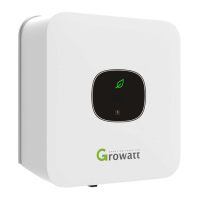Do you have a question about the Growatt MTL-S and is the answer not in the manual?
Troubleshooting steps for 'No AC Connection' error message, including checks for isolator, cables, and warranty claims.
Addresses 'AC V Outrange' errors due to grid voltage outside permitted range or incorrect voltage limits.
Instructions for MTL-S models: setting DIP switch 1 and 5 ON, 2, 3, 4 OFF for AC V Outrange.
For old models, check AC voltage on LCD; proceed if below 262V for AC V Outrange.
Calibrating inverter's voltage sensor using RS232 cable and PC software for AC V Outrange errors.
Remotely change inverter tripping voltage Vmax via ShineServer for specific areas like Ergon Energy, Queensland.
Using ShineBus software and RS232 cable to change voltage settings, including R1 Vac High and 10min Avg.
Troubleshooting 'PV Isolation Low' errors caused by insulation problems, with inspection procedures for DC side.
Troubleshooting 'AC F Outrange' errors related to grid frequency deviation from permitted range.
Troubleshooting 'Over Temperature' errors, suggesting rebooting the inverter or contacting Growatt.
Troubleshooting 'Output High DCI' errors for excessive DC offset current, suggesting reboot or warranty claim.
Troubleshooting 'Residual I high' errors for high leakage current, involving checks and potential warranty claims.
Handling 'PV Voltage High' errors when DC input voltage exceeds tolerable limits, requiring immediate DC switch disconnect.
Troubleshooting 'Auto Test Failed' errors, typically related to leakage current, suggesting inverter reboot.
Guide to selecting the correct country/regulation code (VDE0126-1-1) for inverter setup and operation.
Troubleshooting internal reference voltage faults, with suggestions to reboot or contact Growatt.
Troubleshooting communication errors, including checking line connections and terminals, or contacting Growatt.
Troubleshooting neutral line charged errors by testing line connections and checking for damaged terminals.
Troubleshooting EEPROM faults, suggesting inverter reboot or contacting Growatt for warranty.
Troubleshooting relay faults, with suggestions to reboot the inverter or contact Growatt for warranty.
Troubleshooting init model faults by checking DIP switches and contacting Growatt for warranty.
Troubleshooting GFCI device damage, suggesting inverter reboot or contacting Growatt for warranty.
Troubleshooting HCT faults, with suggestions to reboot the inverter or contact Growatt for warranty.
Troubleshooting bus voltage faults, suggesting inverter reboot or contacting Growatt for warranty.
Troubleshooting 'No display, no light' faults by checking PV array isolator and contacting Growatt.
Troubleshooting 'Display filled with black square' faults by contacting Growatt for warranty.
Troubleshooting 'Inverter keeps reconnecting' faults due to low DC input voltage (< 200V).
Troubleshooting frequent inverter trips due to AC V Outrange, checking isolator tripping.
Troubleshooting AC circuit breaker trips, checking isolator status and contacting Growatt if issues persist.
| Max DC Voltage | 550V |
|---|---|
| AC Voltage Range | 180V-280V |
| THDi | <3% |
| DC Connection Type | MC4 |
| Protection Degree | IP65 |
| Frequency | 50/60 Hz |
| Category | Inverter |
| Rated Output Power | 3000W |
| Rated AC Power | 3000W |
| Rated AC Voltage | 230V |
| AC Connection Type | Plug |
| Operating Temperature Range | -25°C to 60°C |
| Cooling | Natural Cooling |
| Protection | DC Reverse Polarity |












